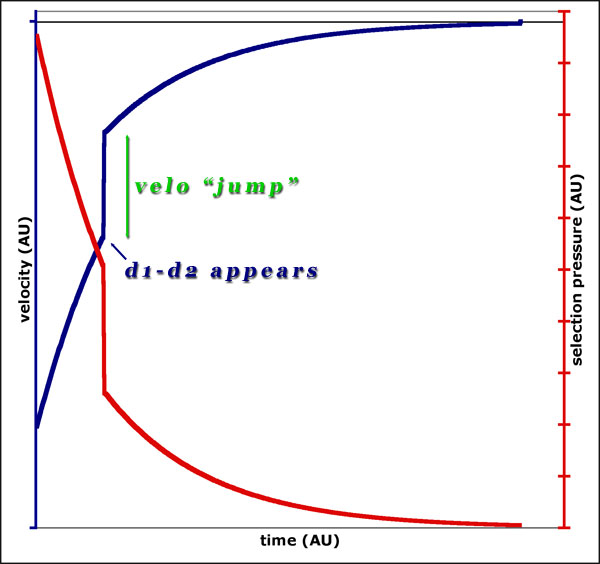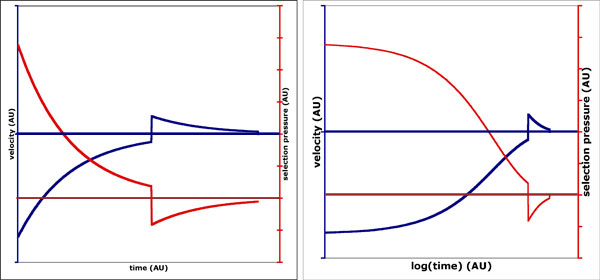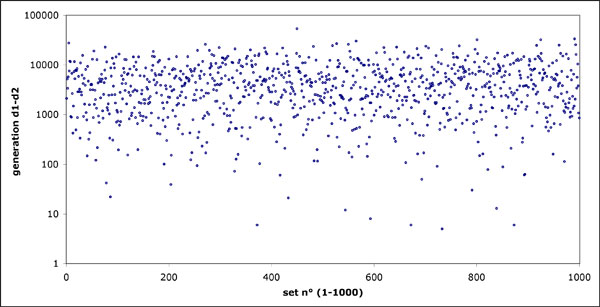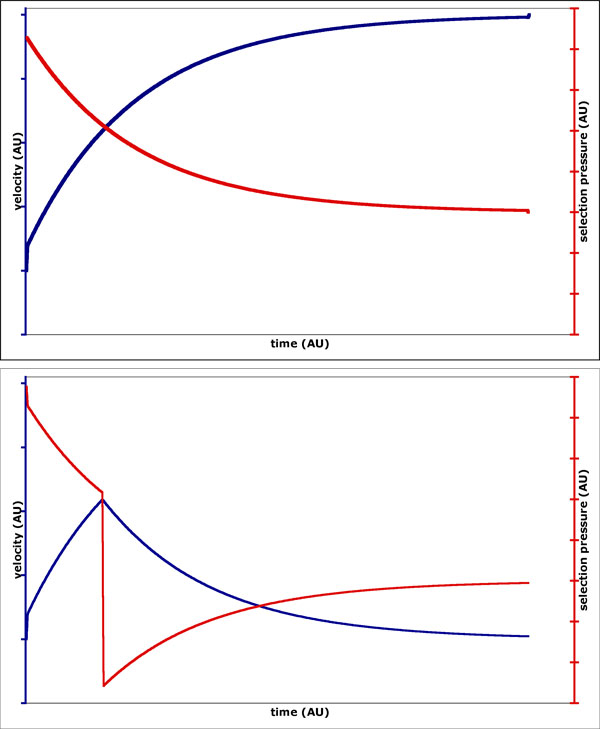J’ai attentivement lu le Point de Vue : « Pour une Science sans a priori« .
Document vraiment intéressant pour au moins trois raisons
- il a trouvé un chemin jusqu’à un journal national
- il est d’une légèreté insoutenable, même par les signatures qui le suivent
- il montre à peu de choses près qu’il est pour une science avec des a priori
Mais avant d’aborder ces trois points : pourquoi l’UIP et ses membres souhaitent si ardemment d’être dissociés de l’Intelligent Design et des Créationistes que ce dernier a longtemps hébergé ouvertement et qu’il cajole toujours, même s’il s’agit des cousins avec qui ils aiment pas trop être vus ?
Probablement parce que l’ID est en train de prendre une pâtée dans son propre fief, les USA, et que son avenir devient de plus en plus sombre. Non pas seulement parce qu’il n’a pas pu accéder au statut de théorie scientifique, la National Academy of Science ayant détruit ses espoirs devant l’absence d’arguments scientifiques, mais aussi ses alliés naturels l’abandonnent progressivement. Et il faut dire que la « Creationist Science » qui avait mué en « Intelligent Design » est dans des draps encore plus sales.
Aujourd’hui, si vous avez la moindre prétention pour une approche surnaturaliste de l’explication du monde il faudrait être suicidaire pour se laisser confondre avec les créationistes et les designists. Mais on peut être irrationnel et pas suicidaire, n’est-ce pas ?
Néanmoins, quelle que soit le credo quant à la façon qu’un éventuel créateur ait agi (ou agit toujours), si on croit à l’existence et l’action d’un créateur on est créationiste. On ne va pas changer la signification du mot juste pour le plaisir de 15 personnes. Quand je dis créationiste, je ne veut pas parler uniquement des YEC, des Young Earth Creationists, cette caste assez particulière pour croire que la Terre est âgée de quelques 6000 ans. Je parle bien des créationistes, façon chrétiens par exemple, qui croient que leur dieu a créé l’univers et dedans a placé l’homme à son image. S’ils ont honte de leur croyance qu’ils le disent clairement. Ils pourront par la suite confesser leur faute et se faire pardonner, s’ils le regrettent vraiment.
Par ailleurs, toute approche téléologique, qui est basée sur un objectif qui a conditionné des actions particulières, par exemple le fine-tuning que certains croient avoir été effectué pour permettre l’apparition de la vie, parle bien d’un dessein, intelligent, stupide ou autre, mais dessein quand même. A ce titre, les chrétiens, pour garder un exemple que je connais bien, croient bien à un dessein intelligent (qui plus qu’un dieu omniscient pourrait prétendre à l’intelligence ?). Que leur Intelligent Design ne corresponde pas à celui prôné et défendu par le Discovery Institut ne signifie pas qu’ils ne desservent pas un Intelligent Design.
Autant je trouve respectable l’attitude d’un chrétien, qui en accord avec sa religion se dit créationiste et défendeur d’un dessein intelligent, autant je trouve méprisables ceux qui réfutent la religion à laquelle ils affirment adhérer, pour éviter qu’ils soient critiqués par leurs adversaires. Avoir l’honnêteté d’afficher clairement ses opinions est la moindre des vertus.
Cracher de la sorte sur sa liberté d’expression est un comportement inqualifiable sans être injurieux.
Passons aux trois points cités en entrée, mais examinons les du troisième au premier.
Non matérialistes de tous les pays unissez vous!!!! C’est le cri de Jean Staune que je vous transmets ici, Jean Staune de l’Université Interdisciplinaire de Paris (association loi 1901). Suivi d’un aperçu de son programme :
réference
PS j’ai lu la réf ci-dessus
Pour plein de raisons que je vous dirais un jour je pense que le ID n’a pas d’avenir
Mais au plan de la forme ma stratégie est proche!
1) partir du réel sans à priori
2) montrer l’insuffisance des approches matérialistes DANS TOUS LES DOMAINES SCIENTIFIQUES
3) unir tous les religions et meme les spiritualités non-religieuses autour de la nouvelle vision de l’homme et du monde issus des sciences
4) voici quelques textes sur cela [non donnés ici]
5) dans tout cela le non- darwinisme joue un role tout à fait mineur!!
6) nos points “fort” sont en physique quantique et en astrophysique voire en mathématiques
Il n’a pas eu encore l’occasion de m’expliquer pourquoi d’après lui l’Intelligent Design (ID pour les intimes) n’a pas d’avenir. Mais il y croit et je comprends pourquoi l’UIP ne veut pas le fréquenter et la nécessité de s’en dissocier par une déclaration publiée dans un journal national. Même si leurs stratégies sont proches.
On ne peut pas dire que l’approche de Jean Staune et de l’UIP sont sans a priori. La cible sont les matérialistes. Même s’il déclare ne pas avoir d’a priori, l’a posteriori se doit d’être « l’insuffisance des approches matérialistes DANS TOUS LES DOMAINES SCIENTIFIQUES » et aboutir à une « internationale agglomération » de tous les non-matérialistes. Tenter de déguiser de la sorte un a priori pourrait être considéré comme une insulte à l’intelligence de son interlocuteur, mais je suis de de bonne humeur et je ne le prends que pour une marque de maladresse. Tenter de rafler les fonds de tiroir non-matérialistes pour obtenir une masse critique est juste pathétique; mais dans ses temps difficiles où le matérialisme semble avoir le vent en poupe je comprends qu’on soit peu regardant quant à ses alliances; il sera toujours temps de régler ses comptes plus tard, doivent penser les uns et les autres.
On retrouve le même sens des a priori dans le texte publié dans Le Monde.
L’a priori le plus important porte sur ce qui est présenté comme un fait : que la majorité de nos contemporains souhaitent une réflexion non pas seulement quant aux implications philosophiques et éthiques des découvertes scientifiques, mais aussi métaphysiques. Il est double ! D’une part on suppose que la majorité de nos contemporains sont intéressés par la métaphysique, ce qui est possible mais certainement pas étayé ici. Mais il y a aussi l’a priori que les découvertes scientifiques vont avoir des conséquences quant à notre approche du métaphysique. Ce qui est loin d’être largement accepté et certainement pas démontré (s’il est démontrable, ce dont je doute)
Dans la version que Jean Staune m’a adressé du texte, il y avait un sous-titre qui n’est pas passé dans la version finale. C’est maladroit de me l’avoir envoyé, puisque je ne résiste pas à l’envie de l’afficher :
Si les scientifiques renoncent à la réflexion métaphysique et spirituelle , ils se couperont de la société
Chacun fera sa lecture, que je vous livre la mienne :
Scientifiques, vous les mal-aimés du public, pour avoir permis le nucléaire avec ses bombes et ses déchets, pour avoir pollué l’atmosphère avec des gaz à effet de serre, pour avoir planté les OGM dans nos champs, pour avoir mis sur le marché des médicaments douteux, il vous reste une planche de salut : la métaphysique et la spiritualité. Si vous ne vous accrochez pas dessus vous resterez des mal-aimés; pire, vous deviendrez une caste d’intouchables peut-être.
Bah ! dans le genre je vais vous mettre la pression et vous foutre la trouille on fait nettement mieux.
Puis, on trouve deux a priori qui sont construits :
L’un, en déclarant que les déistes ne doivent pas être considérés comme créationistes. Parce que le terme créationiste pue ces dernier temps. Malgré le fait que par définition les déistes sont des créationistes.
L’autre, en réfutant que derrière les approches téléologiques et/ou déistes il y a bel et bien un dessein, dans une tentative risible de dégager le principe anthropique (plus téléologique que ça ?) du terme dessein, qui lui aussi pue.
La structure du texte est fort intéressante. Même William Dembski du Discovery Institute qui défend l’Intelligent Design, fait largement mieux. Et j’ai toujours la même impression que son rédacteur n’est pas parmi les signataires.
Qu’il soit légitime de réfléchir aux implications des découvertes et des théories scientifiques il n’y a aucun doute. Pourquoi devrions nous mélanger philosophiques et éthiques avec métaphysiques il n’est pas dit, et encore moins pourquoi il est nécessaire. C’est juste une espèce de vérité annoncé, façon révélation.
Regardez la construction de la phrase : dans la partie a priori vous avez « conceptions religieuses ou métaphysiques » dans l’a posteriori, les « conceptions religieuses » ont disparu, aussi bien que les « conceptions métaphysiques », ces dernières étant remplacées quand même par des « implications métaphysiques », le « métaphysiques » donnant un semblant d’équilibre et étant mis au même niveau que les implications philosophiques et éthiques !
Que Bernard d’Espagnat signe ce texte est étonnant. Je l’avais rangé parmi les rationels, à cause de la conclusion de son exposé « Physique contemporaine et Intelligibilité du monde », qu’il conclu ainsi :
Alors, finalement, le monde est-il intelligible ? À cette question, du moins, je pense que nous pouvons répondre de façon nuancée mais nette. Si par “monde” nous entendons le monde de l’action humaine, la réalité empirique, la réponse est oui : ce monde-là est intelligible et, grâce à la science, nous progressons tous les jours dans sa connaissance. Si, en revanche, par “monde” nous entendons, une Nature à la Spinoza – ce qui est en soi, ou par soi, tout à fait indépendamment de nos facultés de connaître – alors la réponse est non. Ce “monde” là peut, au mieux (et encore!) être deviné.
As-t-il changé d’avis ? As-t-il signé ce texte précipitamment ? J’aimerais bien le savoir.
Ou alors le métaphysique vient de faire son entrée dans le domaine du naturel et c’est passé inaperçu 🙂
La construction du texte est a prendre en considération. Elle est pour le moins floue.
[…]l’American Association for Advancement of Science (AAAS),[…] a-t-elle organisé un colloque sur les « Questions cosmiques » (Cosmic Questions), dont une journée était intitulée : « Y a-t-il un dessein dans l’Univers ? » (« Is the Universe designed ? »). Bien entendu, aucun des supporteurs actuels du Dessein intelligent n’y avait été invité.
Ici nous avons un fait. On s’attendrait à avoir les conclusions du colloque qui éventuellement viendraient supporter l’une ou l’autre des assertions. Il n’en est rien, parce que l’on ne peut conclure sans preuves. Je garderai pour ma part l’appréciation de Steven Weinberg, disant que le fine-tuning est du « mystical mambo-jambo« .
Ce domaine de recherche, qui concerne ce qu’on appelle le « principe anthropique », a donné lieu à de nombreuses publications dans des revues à référés. L’existence de ce réglage a amené certains scientifiques à penser que cela donnait une possibilité nouvelle – mais en aucun cas une preuve – à l’hypothèse de l’existence d’un principe créateur. D’autres contestent vigoureusement cela, sans apporter de preuves du contraire.
On trouve ici le chouchou de l’approche pseudo-scientifiqe par excellence. J’émets une hypothèse, je n’avance aucune preuve, et je te mets au défi de prouver le contraire. Comme si les scientifiques étaient obligés de réfuter toutes les hypothèses gratuites que les uns et les autres ont envie d’emettre.
Le principe qu’il faut étayer ses hypothèses, et les rendre testables semble passer au dessus de la tête des signataires et du rédacteur. S’il y a une chose qui rapproche le Discovery Institute et l’Université Interdisciplinaire de Paris c’est bien cette attitude. Et aucune protestation ne changera les faits.
On retrouve la même légèreté du raisonnement dans les affirmations.
Vouloir se servir de l’existence d’un mouvement comme le Dessein intelligent pour discréditer les scientifiques qui affirment, a posteriori, que les découvertes scientifiques récentes donnent droit de cité, sans les prouver, aux conceptions non matérialistes du monde, c’est effectuer, volontairement ou non, une confusion qu’il convient de dénoncer.
La liberté d’expression est acquise. On peut prétendre n’importe quoi, mais sans preuves il n’est pas possible de gagner le droit de citer en tant qu’approche scientifique, surtout si on prétends parler a posteriori. Il y a comme un défaut de logique là.
Accuser, comme cela a été le cas récemment en France, ces mêmes scientifiques de se livrer à des « intrusions spiritualistes en science », c’est contraire à l’éthique et à la liberté du débat qui doit exister sur les implications philosophiques et métaphysiques des découvertes scientifiques. C’est aussi faire deux poids deux mesures, car ces mêmes personnes n’accusent nullement un Richard Dawkins, par exemple, d' »intrusion matérialiste en science ».
Je trouve que Dawkins fait des intrusions matérialistes en science et qu’il n’y a pas de quoi porter une accusation là, mais de quoi le féliciter. Ses intrusions sont clairement scientifiques. Par contre, pour prendre un exemple qui n’est pas cité, Anne Dambricourt Mallasé fait des intrusions non scientifiques et là il y a de quoi porter une accusation du point de vue du scientifique. Si elle évitait de parler de science et qu’elle se contentait de parler de philosophie je ne pense pas que les scientifiques se trouveraient offusqués ! Mais ça serait contraire à l’éthique scientifique que de la laisser faire sans protester vivement.
La liberté du débat implique que l’on apporte des preuves à ce que l’on avance.
Agir de cette façon, ce n’est pas servir la science. En une période où il existe une crise de vocation importante chez les jeunes pour les carrières scientifiques, où la science est soumise à différentes sortes de critiques, celle-ci se doit d’être la plus ouverte possible (entre autres ouverte à la question du sens) et ne doit pas se refermer autour d’un rationalisme borné caractéristique du scientisme.
Penser un seul instant que l’on doit ouvrir les portes de la science à n’importe qui, sous prétexte que l’on manque de vocations, et éventuellement à l’irrationnel, c’est effrayant ! Et que vient faire le scientisme là dedans ? Etre rationnel est synonyme de borné ? Y-a-t-il un dictionnaire à l’UIP ? Sinon on lance un dictio-thon pour le rédacteur de cette phrase. D’ailleurs, qui a rédigé cette phrase ?
Le texte ne mérite pas les signatures qui le suivent. J’espère qu’il y en a qui vont se rendre compte de leur erreur et qui s’en mordront les doigts et que dans l’avenir ils feront un peu plus attention à ce qu’ils signent. et il ne mérite certainement pas d’être pris au sérieux. Si ce n’est…
Si ne n’est que c’est la preuve d’un lobbying de la part des partisans du métaphysique, pour le faire passer auprès du public et des médias comme une conséquence qui se voudrait normale pour l’interprétation des découvertes scientifiques.
Je doute que les découvertes scientifiques puissent un jour faire la preuve du métaphysique, et là dessus je suis d’accord avec d’Espagnat, si ce n’est que ce qu’il appelle deviner le « monde »je pense être imaginer le « monde », comme les auteurs de fiction le font.
Et je n’irais pas détruire les rêveries d’autrui tant qu’il ne prétend pas que ce sont des faits.
Read Full Post »





ADM-DM-03
Posted in ADM-DM, comments, Darwin, reactions on février 6, 2006| 1 Comment »
Anne Dambricourt Malassé • ADM DM #0 – ADM DM #1 – ADM DM #2 – ADM DM #3
I’ll keep the same here as for parts ADM-DM-01 and ADM-DM-02, Specs in Isle, velo, the gene determining Specs’ velocity, and the same clonal population at time T0.
Let’s consider now three particular mutations of velo gene: velo-d1, velo-d2, which are the same as in ADM-DM-02, and velo-d3.
The genotype d1-d2 is always at the origin of a velo-jump of x%; the genotype d1-d2-d3 produce a velo-jump of n*x%, where n>1. Genotypes d1-d3 and d2-d3 are neutral for velocity.
For equal probabilities of occurrence of the three mutations, p, the probability to observe the triple mutant d1-d2-d3 is p1/2/3 = p3. An event less probable then the double mutant d1-d2, p1/2 = p2.
Statistically the double mutant d1-d2 appears before the triple mutant d1-d2-d3. And the double mutant is necessary to observe a phenotypic impact from the mutation d3.
Once the double mutant d1-d2 present in Specs population it will be fixed as it represents an advantage for the carriers and thus the probability to obtain the triple mutant will increase to p1•2/3 = p !
The step from the initial genotype/phenotype (T0) to the d1-d2 ones (Ts) is expected to be longer then the step from d1-d2 to d1-d2-d3, statistically mean.
The following figure illustrates six runs of the model, with x%, the velo-jump du to d1-d2, equal to 25%, and n = 2, so the velo-jump associated with d1-d2-d3 is of 50%.
Only the mean velocity of the Specs population is represented. There is a story line where d1-d2 wasn’t observed. The rectangular ROI highlights the two velo-jumps. The circular ROI highlights overflows, where the velocity is above the optimal one, and show that the model is still reversible.
Let’s take a look at a particular line story:
Arrows point to the apparition of d1-d2 and d1-d2-d3 and the corresponding velo-jumps. And in this particular example the time lapsed between the wild type and the double mutant is longer then the time lapsed between the double and the triple mutants. This graph represents what one expect to observe as a statistical result.
The graph below was obtained with x% = 25% and n = 2, just for better visualization of the velo-jumps.
We have here a typical situation of overflow. The pic of velocity (red arrow) is du to the effect of d1-d2-d3. The phenotype will reverse as a higher then the optimal velocity isn’t selected, and the optimal velocity will be reached.
Let’s summarize:
What could we get from such a simple model:
The probability to obtain d1-d2-d3 is p1/2/3 = p3
before the apparition of genotype d1-d2,
the probability to obtain d1-d2 is p1/2 = p2, and
the probability to obtain d1-d2-d3 becomes p1•2/3 = p after the apparition of genotype d1-d2.
Thus, p1•2/3 > p1/2 > p1/2/3, which means that the more probable path is to get d1-d2 first, then after a relatively short period d1-d2-d3 (which may be considered as an acceleration of the evolution of velocity).
The model is darwinian, the observations similar to those reported by ADM.
Maybe she could spend some time considering this option before the evocation of Unknown Factors, Internal Plans or any thing else.
To do so, it is necessary to dispose of molecular (genetic) data. A first step would be the determination of genes expressed during the cranium build at the sphenoid region; gene arrays to determine which ones then in situ hybridization, to validate and dispose of a spatial repartition overview. And this for both Homo sapiens and a closely related species, which genome is known, say Pan troglodytes.
If that fails, then something else may be considered.
Technorati tags: Anne Dambricourt, Jean Staune, Intelligent Design, Darwinism, genotype, phenotype
Read Full Post »